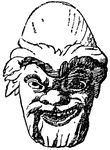Clipart tagged: ‘Graeco’

A Graeco-Ertuscan Chariot
"The chariot was discovered in 1903 in an Ertuscan cemetery near Rome. It dates from perhaps 600 B.C.…

Bacchus Mask
The Bacchus Mask (Greek God of wine) is a Graeco Italic style. It is a fragment of a vessel or utensil.


